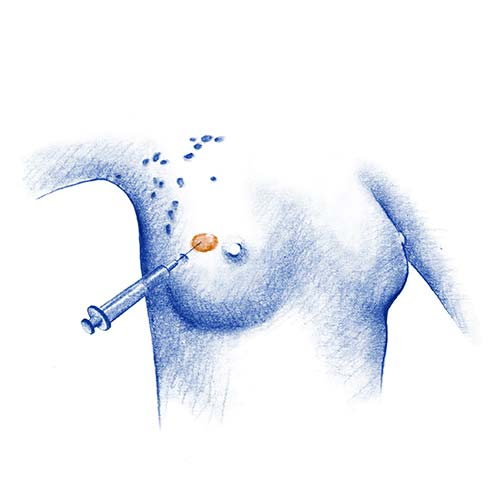Dr. Trigo, José Manuel
Director of Oncology, Research and Innovation

Breast biopsy is an interventional technique where samples of the lesion are removed and studied in the pathology laboratory to tell us exactly what type of lesion it is.
Biopsies may be performed at the time of surgery (such as sentinel node biopsy) or using image-guided puncture by the interventional radiologist on an outpatient basis.
Advantage:
Disadvantages:
This can be performed using ultrasound, stereotaxy, or magnetic resonance.
Procedure:
Advantages:
Disadvantages:
The sentinel node is the first lymph node to which cancer cells are most likely to spread from a primary tumour.
Procedure:
How is a sentinel node biopsy performed?:
Benefits:
Dr. Trigo, José Manuel
Director of Oncology, Research and Innovation
Dr. Jiménez Rodríguez, Begoña
Specialist in Medical Oncology
Clinical Dedication in Breast and Gynecological Cancer
Dr. Sedano Ferreras, Paula
Radiotherapy Oncology Specialist
Dr. García Baltar, José Antonio
Especialista en Radiofísica Hospitalaria
Dr. Rebollo García, Natividad
HC Marbella Radiology Specialist
Dr. Escobar, Ángela
Ginecología y Obstetricia, especialista en la Unidad de Mama
Dr. Bellinvia, Anna Alessandra
HC Marbella Radiology Specialist
Dr. Arrazola, Tomás
Especialista en Farmacia Hospitalaria
Especializado en terapia contra el cáncer, certificado por la Sociedad Americana de Farmacéuticos de Hospital
Dr. López Ibor, Javier
Mental Health
Clinical and Forensic Neuropsychology
Dr. Di Mauro, Pietro
Specialist in the Plastic and Reconstructive Surgery
Tel.: +34 952 908 628
+34 609 148 799
952908898 Oncology
951829978 Diagnosis by imaging
951829947 Gynecology
952908897 Fertility
951829947 Physiotherapy